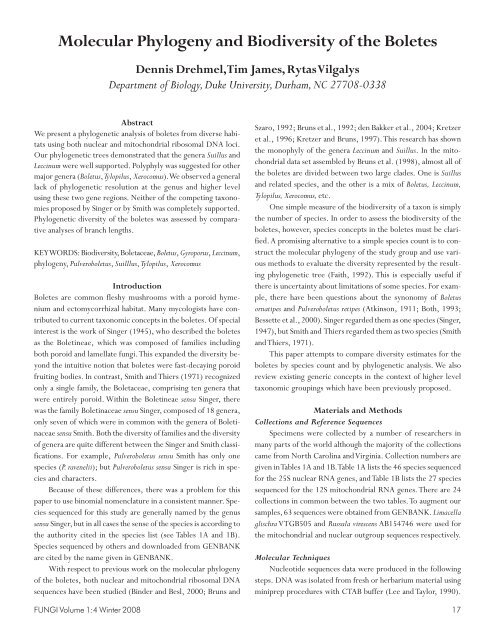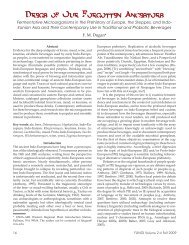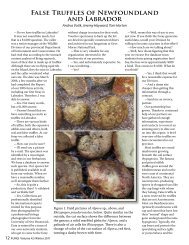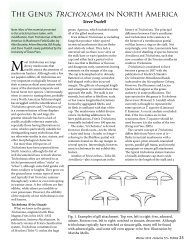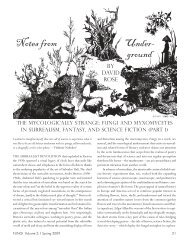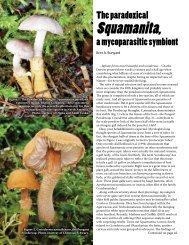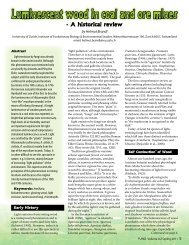Molecular Phylogeny and Biodiversity of the Boletes
Molecular Phylogeny and Biodiversity of the Boletes
Molecular Phylogeny and Biodiversity of the Boletes
Create successful ePaper yourself
Turn your PDF publications into a flip-book with our unique Google optimized e-Paper software.
<strong>Molecular</strong> <strong>Phylogeny</strong> <strong>and</strong> <strong>Biodiversity</strong> <strong>of</strong> <strong>the</strong> <strong>Boletes</strong><br />
Abstract<br />
We present a phylogenetic analysis <strong>of</strong> boletes from diverse habitats<br />
using both nuclear <strong>and</strong> mitochondrial ribosomal DNA loci.<br />
Our phylogenetic trees demonstrated that <strong>the</strong> genera Suillus <strong>and</strong><br />
Leccinum were well supported. Polyphyly was suggested for o<strong>the</strong>r<br />
major genera (Boletus, Tylopilus, Xerocomus). We observed a general<br />
lack <strong>of</strong> phylogenetic resolution at <strong>the</strong> genus <strong>and</strong> higher level<br />
using <strong>the</strong>se two gene regions. Nei<strong>the</strong>r <strong>of</strong> <strong>the</strong> competing taxonomies<br />
proposed by Singer or by Smith was completely supported.<br />
Phylogenetic diversity <strong>of</strong> <strong>the</strong> boletes was assessed by comparative<br />
analyses <strong>of</strong> branch lengths.<br />
KEY WORDS: <strong>Biodiversity</strong>, Boletaceae, Boletus, Gyroporus, Leccinum,<br />
phylogeny, Pulveroboletus, Suilllus, Tylopilus, Xerocomus<br />
Introduction<br />
<strong>Boletes</strong> are common fleshy mushrooms with a poroid hymenium<br />
<strong>and</strong> ectomycorrhizal habitat. Many mycologists have contributed<br />
to current taxonomic concepts in <strong>the</strong> boletes. Of special<br />
interest is <strong>the</strong> work <strong>of</strong> Singer (1945), who described <strong>the</strong> boletes<br />
as <strong>the</strong> Boletineae, which was composed <strong>of</strong> families including<br />
both poroid <strong>and</strong> lamellate fungi. This exp<strong>and</strong>ed <strong>the</strong> diversity beyond<br />
<strong>the</strong> intuitive notion that boletes were fast-decaying poroid<br />
fruiting bodies. In contrast, Smith <strong>and</strong> Thiers (1971) recognized<br />
only a single family, <strong>the</strong> Boletaceae, comprising ten genera that<br />
were entirely poroid. Within <strong>the</strong> Boletineae sensu Singer, <strong>the</strong>re<br />
was <strong>the</strong> family Boletinaceae sensu Singer, composed <strong>of</strong> 18 genera,<br />
only seven <strong>of</strong> which were in common with <strong>the</strong> genera <strong>of</strong> Boletinaceae<br />
sensu Smith. Both <strong>the</strong> diversity <strong>of</strong> families <strong>and</strong> <strong>the</strong> diversity<br />
<strong>of</strong> genera are quite different between <strong>the</strong> Singer <strong>and</strong> Smith classifications.<br />
For example, Pulveroboletus sensu Smith has only one<br />
species (P. ravenelii); but Pulveroboletus sensu Singer is rich in species<br />
<strong>and</strong> characters.<br />
Because <strong>of</strong> <strong>the</strong>se differences, <strong>the</strong>re was a problem for this<br />
paper to use binomial nomenclature in a consistent manner. Species<br />
sequenced for this study are generally named by <strong>the</strong> genus<br />
sensu Singer, but in all cases <strong>the</strong> sense <strong>of</strong> <strong>the</strong> species is according to<br />
<strong>the</strong> authority cited in <strong>the</strong> species list (see Tables 1A <strong>and</strong> 1B).<br />
Species sequenced by o<strong>the</strong>rs <strong>and</strong> downloaded from GENBANK<br />
are cited by <strong>the</strong> name given in GENBANK.<br />
With respect to previous work on <strong>the</strong> molecular phylogeny<br />
<strong>of</strong> <strong>the</strong> boletes, both nuclear <strong>and</strong> mitochondrial ribosomal DNA<br />
sequences have been studied (Binder <strong>and</strong> Besl, 2000; Bruns <strong>and</strong><br />
FUNGI Volume 1:4 Winter 2008<br />
Dennis Drehmel, Tim James, Rytas Vilgalys<br />
Department <strong>of</strong> Biology, Duke University, Durham, NC 27708-0338<br />
Szaro, 1992; Bruns et al., 1992; den Bakker et al., 2004; Kretzer<br />
et al., 1996; Kretzer <strong>and</strong> Bruns, 1997). This research has shown<br />
<strong>the</strong> monophyly <strong>of</strong> <strong>the</strong> genera Leccinum <strong>and</strong> Suillus. In <strong>the</strong> mitochondrial<br />
data set assembled by Bruns et al. (1998), almost all <strong>of</strong><br />
<strong>the</strong> boletes are divided between two large clades. One is Suillus<br />
<strong>and</strong> related species, <strong>and</strong> <strong>the</strong> o<strong>the</strong>r is a mix <strong>of</strong> Boletus, Leccinum,<br />
Tylopilus, Xerocomus, etc.<br />
One simple measure <strong>of</strong> <strong>the</strong> biodiversity <strong>of</strong> a taxon is simply<br />
<strong>the</strong> number <strong>of</strong> species. In order to assess <strong>the</strong> biodiversity <strong>of</strong> <strong>the</strong><br />
boletes, however, species concepts in <strong>the</strong> boletes must be clarified.<br />
A promising alternative to a simple species count is to construct<br />
<strong>the</strong> molecular phylogeny <strong>of</strong> <strong>the</strong> study group <strong>and</strong> use various<br />
methods to evaluate <strong>the</strong> diversity represented by <strong>the</strong> resulting<br />
phylogenetic tree (Faith, 1992). This is especially useful if<br />
<strong>the</strong>re is uncertainty about limitations <strong>of</strong> some species. For example,<br />
<strong>the</strong>re have been questions about <strong>the</strong> synonomy <strong>of</strong> Boletus<br />
ornatipes <strong>and</strong> Pulveroboletus retipes (Atkinson, 1911; Both, 1993;<br />
Bessette et al., 2000). Singer regarded <strong>the</strong>m as one species (Singer,<br />
1947), but Smith <strong>and</strong> Thiers regarded <strong>the</strong>m as two species (Smith<br />
<strong>and</strong> Thiers, 1971).<br />
This paper attempts to compare diversity estimates for <strong>the</strong><br />
boletes by species count <strong>and</strong> by phylogenetic analysis. We also<br />
review existing generic concepts in <strong>the</strong> context <strong>of</strong> higher level<br />
taxonomic groupings which have been previously proposed.<br />
Materials <strong>and</strong> Methods<br />
Collections <strong>and</strong> Reference Sequences<br />
Specimens were collected by a number <strong>of</strong> researchers in<br />
many parts <strong>of</strong> <strong>the</strong> world although <strong>the</strong> majority <strong>of</strong> <strong>the</strong> collections<br />
came from North Carolina <strong>and</strong> Virginia. Collection numbers are<br />
given in Tables 1A <strong>and</strong> 1B. Table 1A lists <strong>the</strong> 46 species sequenced<br />
for <strong>the</strong> 25S nuclear RNA genes, <strong>and</strong> Table 1B lists <strong>the</strong> 27 species<br />
sequenced for <strong>the</strong> 12S mitochondrial RNA genes. There are 24<br />
collections in common between <strong>the</strong> two tables. To augment our<br />
samples, 63 sequences were obtained from GENBANK. Limacella<br />
glischra VTGB505 <strong>and</strong> Russula virescens AB154746 were used for<br />
<strong>the</strong> mitochondrial <strong>and</strong> nuclear outgroup sequences respectively.<br />
<strong>Molecular</strong> Techniques<br />
Nucleotide sequences data were produced in <strong>the</strong> following<br />
steps. DNA was isolated from fresh or herbarium material using<br />
miniprep procedures with CTAB buffer (Lee <strong>and</strong> Taylor, 1990).<br />
17
PCR amplification was accomplished in<br />
accordance with st<strong>and</strong>ard procedures<br />
(Vilgalys <strong>and</strong> Hester, 1990). Primers used<br />
for <strong>the</strong> amplification <strong>of</strong> nLSU-rDNA were<br />
5.8SR <strong>and</strong> LR7. Sequencing primers were<br />
LR0R, LR3R, LR5, <strong>and</strong> LR16 (Hopple<br />
<strong>and</strong> Vilgalys, 1999). Primers for both amplification<br />
<strong>and</strong> sequencing <strong>of</strong> <strong>the</strong> mtSSU<br />
rDNA were MS1 <strong>and</strong> MS2 (White et al.,<br />
1990). Sequences were derived from<br />
fluorescent dye terminator chemistries on<br />
an automated ABI 377 sequencer.<br />
Data Analysis<br />
For nLSU-rDNA, <strong>the</strong> aligned data<br />
matrix consisted <strong>of</strong> 854 characters, 510<br />
characters were constant, 223 variable<br />
characters were parsimony informative.<br />
For <strong>the</strong> mtSSU-rDNA, <strong>the</strong> aligned data<br />
matrix had 466 included characters, 278<br />
were constant, <strong>and</strong> 121 were parsimony<br />
informative. Character congruence between<br />
<strong>the</strong> nLSU <strong>and</strong> mtSSU sequences<br />
was evaluated with <strong>the</strong> incongruence<br />
length difference test <strong>of</strong> Farris et al. (1994)<br />
by means <strong>of</strong> <strong>the</strong> partition-homogeneity<br />
test in PAUP. A third data matrix was assembled<br />
using additional sequences from<br />
GENBANK to represent taxonomic diversity<br />
across <strong>the</strong> boletes. For this matrix<br />
<strong>the</strong>re were 360 constant characters <strong>and</strong><br />
331 were parsimony informative. Analyses<br />
were conducted using PAUP (Sw<strong>of</strong>ford,<br />
1998). Maximum parsimony trees<br />
were found using heuristic searching <strong>and</strong><br />
significance assessed using stepwise-addition<br />
bootstrap replicates.<br />
Results<br />
The molecular phylogenetic trees <strong>of</strong> nuclear<br />
<strong>and</strong> mitochondrial rDNA are shown<br />
in Fig. 1 <strong>and</strong> Fig. 2, respectively (see pages<br />
20 <strong>and</strong> 21). Both phylogenies share one<br />
striking feature which is <strong>the</strong> large degree<br />
<strong>of</strong> separation between <strong>the</strong> Suillus clade <strong>and</strong><br />
<strong>the</strong> rest <strong>of</strong> <strong>the</strong> boletes. In Fig. 1, <strong>the</strong> Suillus<br />
clade includes Gomphidius <strong>and</strong> Truncocolumella<br />
with perfect bootstrap support.<br />
O<strong>the</strong>r clades with good support are <strong>the</strong><br />
Leccinum clade at 98% <strong>and</strong> <strong>the</strong> grouping <strong>of</strong><br />
Table 1A. Taxa included in <strong>the</strong> nLSU-rDNA phylogeny (generated in this<br />
study).<br />
Name Location Collection<br />
Austroboletus betula (Schwein.) E. Horak Orange Co. NC DD9852<br />
Austroboletus mucosus (Corner) Wolfe Guyana* TH6300<br />
Boletellus ananas (M.A. Curtis) Murril Guyana TH6264<br />
Boletus bicolor Peck Watuaga Co. NC TH6933<br />
Boletus communis Bull. Watuaga Co. NC NCJ25<br />
Boletus edulis Bull. : Fr. Orange Co. NC HN141<br />
Boletus inedulis (Murril) Murril Watuaga Co. NC NCJ14<br />
Boletus subvelutipes Peck Giles Co. VA RV98.102<br />
Boletus viridiflavus Coker & Beers Orange Co. NC DD972<br />
Gomphidius glutinosus (Schaeff. : Fr.) Fr. Macon Co. NC RY1290<br />
Gyrodon merulioides (Schwein.) Singer Watuaga Co. NC NCJ12<br />
Gyroporus castaneus (Bull. : Fr.) Quél. Watuaga Co. NC NCJ16<br />
Gyroporus cyanescens (Bull. : Fr.) Quél. Montgomery Co. VA OKM9827<br />
Leccinum albellum (Peck) Singer Watuaga Co. NC TH6968<br />
Leccinum aurantiacum (Bull.) Gray Giles Co. Va HN1573<br />
Leccinum rubropunctum (Peck) Singer Watuaga Co. NC TH6944<br />
Leccinum rugosiceps (Peck) Singer Watuaga Co. NC TH6967<br />
Leccinum scabrum (Bull. : Fr.) Gray Watuaga Co. NC NCJ26<br />
Paxillus involutus (Batsch : Fr.) Fr. Watuaga Co. NC RV98.135<br />
Phaeogyroporus sp. Singer Australia** OKM23801<br />
Phlebopus beniensis (Singer & Digilio)<br />
Heinem. & Rammeloo<br />
Puerto Rico Omon 98.015<br />
Phylloporus rhodoxanthus (Schwein.) Bres. Durham Co. NC SAR89<br />
Pulveroboletus auriflammeus (Berk. &<br />
M.A. Curtis) Singer<br />
Orange Co. NC DD973<br />
Pulveroboletus auriporus (Peck) Singer Orange Co. NC DD971<br />
Pulveroboletus curtisii (Berk.) Singer Watuaga Co. NC TH6943<br />
Pulveroboletus retipes (Berk. &<br />
M.A. Curtis) Singer<br />
Giles Co. VA RV98.127<br />
Rubinoboletus ballouii (Peck) Heinem.<br />
& Rammeloo<br />
Guyana TH6385<br />
Strobilomyces floccopus (Vahl : Fr.) P. Karst. Orange Co. NC HN0027<br />
Suillus americanus (Peck) Snell Giles Co. VA RV98.116<br />
Suillus grevillei (Klotzsch : Fr.) Singer Japan*** HN3469<br />
Suillus hirtellus (Peck) Snell Durham Co. NC NCJ04<br />
Suillus luteus (L.) Roussel Durham Co. NC JM96/41<br />
Suillus pictus (Peck) A.H. Sm. & Thiers Giles Co. VA RV98.115<br />
Suillus punctipes (Peck) Singer Watuaga Co. NC NCJ17<br />
Truncocolumella citrina Zeller Payette Nat. For. ID OKM25732<br />
Tylopilus alboater (Schwein.) Murrill Durham Co. NC TH6941<br />
Tylopilus badiceps (Peck) A.H. Sm. & Thiers Watuaga Co. NC NCJ20<br />
Tylopilus chromapes (Frost) A.H. Sm. & Thiers Giles Co. VA RV98.107<br />
Tylopilus rufonigricans T.W. Henkel Guyana TH6376<br />
Tylopilus rhoadsiae (Murrill) Murrill Giles Co. VA RV98.261<br />
Tylopilus tabacinus (Peck) Singer Durham Co. NC HN2295<br />
Xanthoconium affine (Peck) Singer Giles Co. VA RV98.112<br />
Xerocomus amazonicus Singer Guyana TH6304<br />
Xerocomus illudens (Peck) Singer Orange Co. NC DD9854<br />
Xerocomus sp. Singer Giles Co. VA RV98.123<br />
Xerocomus spadiceus (Fr.) Quél. Clallam Co. WA OKM25919<br />
* All Guyana collections from <strong>the</strong> Pakaraima mountains<br />
** Wongamie nature preserve near Toodyay<br />
*** Yamaanashi prefecture near Mt. Fuji<br />
18 FUNGI Volume 1:4 Winter 2008
Table 1B. Taxa included in <strong>the</strong> mitSSU-rDNA phylogeny (generated in<br />
this study).<br />
Name Location Collection<br />
Austroboletus mucosus (Corner) Wolfe Guyana* TH6300<br />
Boletellus ananas (M.A. Curtis) Murril Guyana TH6264<br />
Boletus edulis Bull. : Fr. Orange Co. NC HN141<br />
Boletus inedulis (Murril) Murril Watuaga Co. NC NCJ14<br />
Boletus ornatipes Peck Watuaga Co. NC TYJ15<br />
Boletus viridiflavus Coker & Beers Orange Co. NC DD972<br />
Chalciporus piperatus (Bull. : Fr.) Bataille Watuaga Co. NC TYJ21<br />
Gyroporus castaneus (Bull. : Fr.) Quél. Watuaga Co. NC NCJ16<br />
Leccinum albellum (Peck) Singer Watuaga Co. NC TH6968<br />
Leccinum rubropunctum (Peck) Singer Watuaga Co. NC TH6944<br />
Pulveroboletus auriflammeus (Berk. &<br />
M.A. Curtis) Singer<br />
Orange Co. NC DD973<br />
Pulveroboletus auriporus (Peck) Singer Orange Co. NC DD971<br />
Pulveroboletus curtisii (Berk.) Singer Watuaga Co. NC TH6943<br />
Pulveroboletus retipes (Berk. & M.A. Curtis) Singer Giles Co. VA RV98.127<br />
Paxillus involutus (Batsch : Fr.) Fr. Watuaga Co. NC RV98.135<br />
Rubinoboletus ballouii (Peck) Heinem.<br />
& Rammeloo<br />
Guyana TH6385<br />
Strobilomyces floccopus (Vahl : Fr.) P. Karst. Orange Co. NC HN0027<br />
Suillus americanus (Peck) Snell Giles Co. VA RV98.116<br />
Suillus granulatus (L.) Roussel Giles Co. VA RV98.114<br />
Suillus grevillei (Klotzsch : Fr.) Singer Japan** HN3469<br />
Suillus hirtellus (Peck) Snell Durham Co. NC NCJ04<br />
Tylopilus badiceps (Peck) A.H. Sm. & Thiers Watuaga Co. NC NCJ20<br />
Tylopilus rufonigricans T.W. Henkel Guyana TH6376<br />
Tylopilus tabacinus (Peck) Singer Durham Co. NC HN2295<br />
Xanthoconium affine (Peck) Singer Giles Co. VA RV98.112<br />
Xerocomus amazonicus Singer Guyana TH6304<br />
Xerocomus sp. Giles Co. VA RV98.123<br />
* All Guyana collections from <strong>the</strong> Pakaraima mountains<br />
** Yamaanashi prefecture near Mt. Fuji<br />
Table 2. <strong>Biodiversity</strong> Index Results<br />
Grouping Number in Group Index<br />
All 108 24<br />
Boletoid clade (see note 1) 91 23<br />
Boletus 25 26<br />
Leccinum 13 21<br />
Sulloid clade (see note 2) 13 16<br />
Suillus 8 13<br />
Tylopilus 13 22<br />
Xerocomus 11 19<br />
Basal part <strong>of</strong> tree (see note 3) 17 27<br />
Note 1: Boletoid clade includes Austroboletus, Boletus, Gyroporus, Leccinum,<br />
Melanogaster, Paxillus, Phaeogyroporus, Phlebopus, Phylloporus, Pisolithus,<br />
Pulveroboletus, Rubinoboletus, Scleroderma, Strobilomyces, Tylopilus,<br />
Xanthoconium, <strong>and</strong> Xerocomus.<br />
Note 2: Suilloid clade includes Chroogomphus, Gomphidius, Rhizopogon, Suillus,<br />
<strong>and</strong> Truncoclumella.<br />
Note 3: Basal portion <strong>of</strong> <strong>the</strong> tree includes Sulloid clade, Coniophora,<br />
Hygrophoropsis, <strong>and</strong> Tapinella.<br />
FUNGI Volume 1:4 Winter 2008<br />
Gyrodon, Phaeogyroporus, <strong>and</strong> Phlebopus (GPP<br />
group) at 79%. Overall, <strong>the</strong> phylogenetic<br />
tree appears to have four major branches:<br />
1) Phylloporus, Pulveroboletus, <strong>and</strong><br />
Xerocomus (PPX group)<br />
2) Leccinum <strong>and</strong> miscellaneous associates<br />
3) Boletus, Tylopilus <strong>and</strong> miscellaneous<br />
4) Suillus <strong>and</strong> <strong>the</strong> GPP group noted above<br />
The parsimony analysis <strong>of</strong> a larger<br />
bolete data set (this study <strong>and</strong> GENBANK<br />
sequences) was performed to calculate<br />
bootstrap support data on major branches.<br />
This nLSU-rDNA phylogeny <strong>of</strong> boletes<br />
including 63 sequences from GENBANK<br />
resulted in 98 most parsimonious trees<br />
(length=2662). These trees have a consistency<br />
index <strong>of</strong> 0.3509, a homoplasy<br />
index <strong>of</strong> 0.6491, <strong>and</strong> a retention index <strong>of</strong><br />
0.6026. As it was with <strong>the</strong> smaller data<br />
set, this analysis shows large groups dominated<br />
by particular genera. For example,<br />
<strong>the</strong>re is again a PPX group as noted above.<br />
However, in this case <strong>the</strong>re is ano<strong>the</strong>r cluster<br />
<strong>of</strong> Xerocomus outside <strong>of</strong> <strong>the</strong> PPX group.<br />
Also, as before <strong>the</strong>re are well-supported<br />
branches for each <strong>of</strong> Leccinum <strong>and</strong> Suillus.<br />
Unlike <strong>the</strong> smaller data set, <strong>the</strong>re is<br />
not a single branch for most <strong>of</strong> Boletus <strong>and</strong><br />
Tylopilus but ra<strong>the</strong>r a series <strong>of</strong> small groups<br />
that are closely related. There appear to<br />
be at least three small groups dominated<br />
by Boletus <strong>and</strong> two by Tylopilus. In addition<br />
to <strong>the</strong> small GPP group that was seen in<br />
Fig. 1, <strong>the</strong>re are two o<strong>the</strong>r small groups:<br />
1) Gyroporus <strong>and</strong> Scleroderma; 2) Chroogomphus<br />
<strong>and</strong> Gomphidius.<br />
With <strong>the</strong> scattered appearance <strong>of</strong> genera<br />
such as Boletus <strong>and</strong> Tylopilus, <strong>the</strong> question<br />
is whe<strong>the</strong>r <strong>the</strong>re is enough evidence<br />
to suggest that <strong>the</strong>se groups will never be<br />
single, compact groups. In order to check<br />
<strong>the</strong> monophyly <strong>of</strong> <strong>the</strong> major genera within<br />
<strong>the</strong> boletes, <strong>the</strong> large bolete data set (109<br />
taxa) was analyzed using constraints which<br />
forced a particular genus to be single compact<br />
group. Using distance by <strong>the</strong> “uncorrected<br />
p” method as <strong>the</strong> optimizing criterion,<br />
phylogenies were generated with <strong>and</strong><br />
(Continued on page 22)<br />
19
98<br />
79<br />
70<br />
Austroboletus betula DD9852<br />
Pulveroboletus auriflammeus DD973<br />
Boletus viridiflavus DD972<br />
Pulveroboletus auriporus DD971<br />
Xerocomus amazonicus TH6304<br />
Phylloporus rhodoxanthus SAR89<br />
Xerocomus illudens DD9854<br />
Xerocomus sp RV98.123<br />
Pulveroboletus curtisii TH6943<br />
Pulveroboletus retipes RV98.127<br />
Austroboletus mucosus TH6300<br />
Leccinum aurantiacum HN1573<br />
Leccinum scabrum NCJ26<br />
Leccinum rubropunctum TH6944<br />
Leccinum albellum TH6968<br />
Leccinum rugosiceps TH6967<br />
Boletus edulis HN141<br />
Tylopilus chromapes RV98.107<br />
Tylopilus rhoadsiae RV98.261<br />
Xerocomus spadiceus OKM25919<br />
Boletellus ananas TH6264<br />
Gyroporus castaneus NCJ16<br />
Strobilomyces floccopus HN0027<br />
Boletus bicolor TH6933<br />
Boletus subvelutipes RV98.102<br />
Boletus inedulis NCJ14<br />
Tylopilus alboater TH6941<br />
Tylopilus rufonigricans TH6376<br />
Tylopilus tabacinus HN2295<br />
Tylopilus badiceps NCJ20<br />
Xanthoconium affine RV98.112<br />
Gomphidius glutinosus RY1290<br />
Suillus luteus JM96.41<br />
100<br />
83<br />
90<br />
84<br />
100<br />
Suillus punctipes NCJ17<br />
Suillus hirtellus NCJ04<br />
Suillus pictus RV98.115<br />
Suillus americanus RV98.116<br />
Suillus grevillei HN3469<br />
Truncocolumella citrina OKM25732<br />
Gyrodon merulioides NCJ12<br />
Phaeogyroporus sp. OKM23801<br />
Phlebopus beniensis Omon 98.015<br />
Paxillus involutus RV98.135<br />
Boletus communis NCJ25<br />
Rubinoboletus ballouii TH6385<br />
Gyroporus cyanescens OKM9827<br />
Limacella glishra VTGB505<br />
98<br />
79<br />
97<br />
10 changes<br />
Figure 1. nLSU-rDNA phylogeny <strong>of</strong> boletes. One <strong>of</strong> 8 most parsimonious trees<br />
(length = 1,314). Shown is <strong>the</strong> most likely tree determined using a model with 2<br />
substitution types <strong>and</strong> a trasition to transversion ratio <strong>of</strong> 2. The tree had a consistency<br />
index <strong>of</strong> 0.4271, a homoplasy index <strong>of</strong> 0.5729, <strong>and</strong> a retention index <strong>of</strong><br />
0.5132. Above <strong>the</strong> nodes are bootstrap values generated using 1000 replicates<br />
(only values greater or equal to 70% are shown).<br />
20 FUNGI Volume 1:4 Winter 2008
88<br />
100<br />
88<br />
FUNGI Volume 1:4 Winter 2008<br />
82<br />
99<br />
95<br />
Gyroporus castaneus NCJ16<br />
Suillus americanus RV98.116<br />
Suillus granulatus RV98.114<br />
Suillus hirtellus NCJ04<br />
Suillus grevillei TH3469<br />
Austroboletus mucosus TH6300<br />
Boletellus ananas TH6264<br />
Strobilomyces floccopus HN0027<br />
Pulveroboletus retipes RV98.127<br />
Boletus inedulis NCJ14<br />
Boletus ornatipes TYJ15<br />
Pulveroboletus curtisii TH6943<br />
Tylopilus badiceps NCJ20<br />
Tylopilus tabacinus HN2295<br />
Pulveroboletus auriflammeus DCD972<br />
Rubinoboletus ballouii TH6385<br />
Xerocomus amazonicus TH6304<br />
Xanthoconium affine RV98.112<br />
Tylopilus rufonigricans TH6376<br />
Boletus edulis HN141<br />
Leccinum albellum TH6968<br />
Leccinum rubropunctum TH6944<br />
Xerocomus sp. RV98.123<br />
Boletus viridiflavus DCD973<br />
Pulveroboletus auriporus DCD971<br />
Chalciporus piperatus TYJ21<br />
Paxillus involutus RV98.135<br />
Limacella glishra VTGB505<br />
Figure 2. mtSSU-rDNA phylogeny <strong>of</strong> boletes. There were 54 most parsimonious<br />
trees (length = 345). Shown is <strong>the</strong> most likely tree with a consistency index<br />
<strong>of</strong> 0.7014, a homoplasy index <strong>of</strong> 0.2986, <strong>and</strong> a retention index <strong>of</strong> 0.7785.<br />
5 changes<br />
21
without constraints. The resultant tree scores were compared by<br />
<strong>the</strong> Templeton test <strong>and</strong> <strong>the</strong> Kishino-Hasegawa test. Those genera<br />
which showed a significant effect <strong>of</strong> <strong>the</strong> constraint were Boletus,<br />
Pulveroboletus, Tylopilus, <strong>and</strong> Xerocomus. This suggests that <strong>the</strong>se genera<br />
are not monophyletic groups.<br />
Results from <strong>the</strong> biodiversity analysis are shown in Table 2.<br />
These results are based on <strong>the</strong> larger bolete data set. Distance<br />
derived branch lengths (by <strong>the</strong> “uncorrected p” method ) were<br />
totaled for major clades, major genera, <strong>and</strong> a few minor genera.<br />
The biodiversity index was evaluated as <strong>the</strong> total branch length<br />
for a chosen group divided by <strong>the</strong> total number <strong>of</strong> taxa for that<br />
group. Table 2 show that <strong>the</strong>re is a significant difference in <strong>the</strong><br />
biodiversity index ranging from a low <strong>of</strong> 13 to a high <strong>of</strong> 27. In<br />
o<strong>the</strong>r words, <strong>the</strong> biodiversity estimates given by biodiversity estimates<br />
from genetic analysis could differ from simply counting<br />
species by as much as a factor <strong>of</strong> two.<br />
Discussion<br />
The analyses reported here provide new insights into <strong>the</strong> relationships<br />
<strong>and</strong> diversity <strong>of</strong> bolete taxa. These results are consistent<br />
with previous estimates <strong>of</strong> <strong>the</strong> phylogeny <strong>of</strong> <strong>the</strong> Boletales, suggesting<br />
a deep divergence between suilloid fungi <strong>and</strong> Boletus <strong>and</strong><br />
allies <strong>and</strong> a distinct Leccinum clade. Though lacking resolution,<br />
<strong>the</strong> mitochondrial rDNA data also gave a tree with distinct clades<br />
for Suillus <strong>and</strong> for a mix <strong>of</strong> o<strong>the</strong>r major genera. In order to compare<br />
<strong>the</strong> topologies <strong>of</strong> <strong>the</strong> nLSU-rDNA <strong>and</strong> mtSSU-rDNA genes,<br />
<strong>the</strong> data for species common to both data sets were combined<br />
<strong>and</strong> subject to <strong>the</strong> partition homogeneity test. The p value was<br />
0.01 indicating that <strong>the</strong> data supported significantly different topologies.<br />
This means that <strong>the</strong> different genes give significantly<br />
different trees <strong>and</strong> <strong>the</strong> phylogenies are not congruent.<br />
The tree resulting from <strong>the</strong> combined bolete data set with<br />
bootstrap support analysis provides information regarding questions<br />
about groupings <strong>of</strong> species. For a particular genus, <strong>the</strong> species<br />
<strong>of</strong> that genus may be found in only one group, in two groups,<br />
in many groups, or scattered throughout <strong>the</strong> phylogenetic tree.<br />
For <strong>the</strong> following genera, <strong>the</strong>ir representative species are found<br />
in only one group which is well supported by bootstrap analysis:<br />
Chroogomphus, Coniophora, Gyroporous, Leccinum, Phlebopus, Phylloporus,<br />
<strong>and</strong> Suillus. However, species <strong>of</strong> Xerocomus are in two distinct<br />
groups <strong>and</strong> groupings <strong>of</strong> Boletus, Pulveroboletus, <strong>and</strong> Tylopilus are<br />
scattered throughout <strong>the</strong> tree. As noted in <strong>the</strong> Results section,<br />
constraint analysis argues against monophyly <strong>of</strong> Boletus, Pulveroboletus,<br />
Tylopilus, <strong>and</strong> Xerocomus.<br />
A tree branch dominated by Leccinum is interesting because it<br />
contains Boletus longicurvipes <strong>and</strong> B. subglabripes, which were part<br />
<strong>of</strong> a group labeled by Smith as pseudoleccinum. A detailed analysis<br />
<strong>of</strong> Leccinum sensu stricto <strong>and</strong> related species is given by Binder<br />
<strong>and</strong> Besl (2000). They limit Leccinum to sections Leccinum <strong>and</strong><br />
Scabra, which are characterized by whitish flesh. O<strong>the</strong>rs with<br />
yellowish flesh may be excluded from genus Leccinum. Never<strong>the</strong>less,<br />
<strong>the</strong> pseudoleccinums are very closely related to genus<br />
Leccinum by <strong>the</strong> 98% bootstrap support for <strong>the</strong> clade containing<br />
<strong>the</strong> pseudoleccinums, <strong>the</strong> Leccinum sensu stricto, <strong>and</strong> <strong>the</strong> o<strong>the</strong>r<br />
leccinums.<br />
Many <strong>of</strong> <strong>the</strong> genera that Singer included in <strong>the</strong> Boletaceae<br />
were not included in this analysis. However, our results did support<br />
<strong>the</strong> inclusion <strong>of</strong> Phlebopus <strong>and</strong> Phaeogyroporus in this group. In<br />
addition, <strong>the</strong> data suggest that <strong>the</strong> lamellate forms (Paxillus <strong>and</strong><br />
Phylloporus) are derived from poroid boletes. Our phylogenies<br />
supported <strong>the</strong> inclusion <strong>of</strong> Boletellus <strong>and</strong> Strobilomyces within <strong>the</strong><br />
Boletaceae as posited by Smith <strong>and</strong> Thiers. Nei<strong>the</strong>r <strong>the</strong> Singer nor<br />
<strong>the</strong> Smith Boletaceae is monophyletic; both are ra<strong>the</strong>r unwieldy<br />
<strong>and</strong> would benefit by fur<strong>the</strong>r taxonomic divisions.<br />
With respect to bolete biodiversity, most <strong>of</strong> <strong>the</strong> larger genera<br />
have diversity in line with <strong>the</strong> total number <strong>of</strong> taxa in that<br />
genus. However, <strong>the</strong> genus Suillus showed only two thirds <strong>of</strong> <strong>the</strong><br />
diversity <strong>of</strong> most o<strong>the</strong>r groupings. Until our sampling can include<br />
additional taxa from western North America <strong>and</strong> Europe,<br />
our results on biodiversity must be considered preliminary.<br />
References<br />
Atkinson, G. F. 1911. Mushrooms. Henry Holt <strong>and</strong> Co., New York.<br />
Bessette, A. E., W. C. Roody, <strong>and</strong> A. R. Bessette,. 2000. North American<br />
<strong>Boletes</strong>, Syracuse University Press, Syracuse, New York.<br />
Binder, M. <strong>and</strong> H. Besl. 2000. 28S rDNA sequence data <strong>and</strong> chemotaxonomical<br />
analyses on <strong>the</strong> generic concept <strong>of</strong> Leccinum (Boletales). In:<br />
Associazone Micologica Bresadola (Micologia 2000, Ed.), pp. 75–86,<br />
Grafica Sette, Brescia, Italy.<br />
Both, E. E. 1993. The <strong>Boletes</strong> <strong>of</strong> North America. Buffalo Museum <strong>of</strong> Science,<br />
Buffalo, New York.<br />
Bruns, T. D. <strong>and</strong> T. M. Szaro. 1992. Rate <strong>and</strong> mode differences between<br />
nuclear <strong>and</strong> mitochondrial small-subunit rDNA genes in mushrooms.<br />
<strong>Molecular</strong> Biology <strong>and</strong> Evolution 9: 836–55.<br />
Bruns, T. D., T. M. Szaro, M. Gardes, K. W. Cullings, J. Pan, D. L. Taylor,<br />
T. R. Horton, A. Kretzer, M. Garbelotto, <strong>and</strong> Y. Li. 1998. A sequence<br />
data base for <strong>the</strong> identification <strong>of</strong> ectomycorrhizal basidiomycetes by<br />
phylogenetic analysis. <strong>Molecular</strong> Ecology 7: 257–72.<br />
Bruns, T. D., R. Vilgalys, <strong>and</strong> S. M. Barns. 1992. Evolutionary relationships<br />
within <strong>the</strong> fungi: analyses <strong>of</strong> nuclear small subunit rDNA sequences.<br />
<strong>Molecular</strong> Phylogenetics <strong>and</strong> Evolution 1: 231–41.<br />
Den Bakker, H., B. Gravendeel, <strong>and</strong> T. W. Kuyper. 2004. An ITS phylogeny<br />
<strong>of</strong> Leccinum <strong>and</strong> an analysis <strong>of</strong> <strong>the</strong> evolution <strong>of</strong> minisatellite-like sequences<br />
within ITS1. Mycologia 96: 102–18.<br />
Faith, D. P. 1992. Conservation evaluation <strong>and</strong> phylogenetic diversity.<br />
Biological Conservation 61: 1–10.<br />
Farris, J. S., M. Kallersjo, A. G. Kluge, <strong>and</strong> C. Bult. 1994. Testing significance<br />
<strong>of</strong> incongruence. Cladistics 10: 315–19.<br />
Hopple, J. S. <strong>and</strong> R. Vilgalys. 1999. Phylogenetic relationships in <strong>the</strong><br />
mushroom genus Coprinus <strong>and</strong> dark-spored allies based on sequence<br />
22 FUNGI Volume 1:4 Winter 2008
data from <strong>the</strong> nuclear gene coding for <strong>the</strong> large ribosomal subunit<br />
RNA: Divergent domains, outgroups <strong>and</strong> monophyly. <strong>Molecular</strong><br />
Phylogenetics <strong>and</strong> Evolution 13: 1–19.<br />
Kretzer, A., Li, Y., Szaro, T., <strong>and</strong> Bruns, T. D. 1996. Internal transcribed<br />
spacer sequences from 38 recognized species <strong>of</strong> Suillus sensu lato: Phylogenetic<br />
<strong>and</strong> taxonomic implications. Mycologia 88: 776-785.<br />
Kretzer, A., <strong>and</strong> Bruns, T. D. 1997. <strong>Molecular</strong> revisitation <strong>of</strong> <strong>the</strong> genus<br />
Gastrosuillus. Mycologia 89: 776–85.<br />
Lee, S. B. <strong>and</strong> Taylor, J. W. 1990. Isolation <strong>of</strong> DNA from fungal mycelia <strong>and</strong><br />
single spores. In: PCR Protocols: A Guide to Methods <strong>and</strong> Applications<br />
(M.A. Innis, D. H. Gelf<strong>and</strong>, J. J. Sninsky <strong>and</strong> T. J. White, Eds.) pp 282-<br />
287, Academic Press, NYk.<br />
Singer, R. 1945. The Boletineae <strong>of</strong> Florida. Farlowia 2: 97–141.<br />
FUNGI Volume 1:4 Winter 2008<br />
Singer R. 1947. The Boletoideae <strong>of</strong> Florida. American Midl<strong>and</strong> Naturalist 37:<br />
1–135.<br />
Smith, A., <strong>and</strong> Thiers, H. D. 1971. <strong>Boletes</strong> <strong>of</strong> Michigan. University <strong>of</strong> Michigan<br />
Press. Ann Arbor, MI.<br />
Sw<strong>of</strong>ford, D. L. 1998. PAUP*: Phylogenetic analysis using parsimony<br />
(*<strong>and</strong> o<strong>the</strong>r methods). Sinauer, Sunderl<strong>and</strong>, IL.<br />
Vilgalys, R. <strong>and</strong> Hester, M. 1990. Rapid genetic identification <strong>and</strong> mapping<br />
<strong>of</strong> enzymatically amplified ribosomal DNA from several Cryptococcus<br />
species.Journal <strong>of</strong> Bacteriology 172: 4238–46.<br />
White, T. J., Bruns, T. Lee, S. <strong>and</strong> Taylor, J. 1990. Amplification <strong>and</strong> direct<br />
sequencing <strong>of</strong> fungal ribosomal RNA genes for phylogenetics. In: PCR<br />
Protocols: A Guide to Methods <strong>and</strong> Applications (M.A. Innis, D. H. Gelf<strong>and</strong>,<br />
J. J. Sninsky <strong>and</strong> T. J. White, Eds.) pp 282–87, Academic Press, NY.<br />
23


